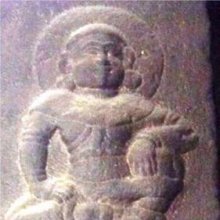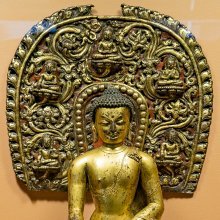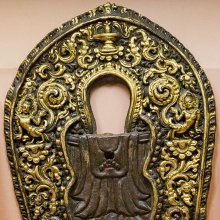Prabhamandala, Prabhāmaṇḍala, Prabha-mandala, Prabhamamdala: 9 definitions
Introduction:
Prabhamandala means something in Buddhism, Pali, Hinduism, Sanskrit. If you want to know the exact meaning, history, etymology or English translation of this term then check out the descriptions on this page. Add your comment or reference to a book if you want to contribute to this summary article.
Images (photo gallery)
In Buddhism
Tibetan Buddhism (Vajrayana or tantric Buddhism)
Source: Brill: Śaivism and the Tantric Traditions (tantric Buddhism)Prabhāmaṇḍala (प्रभामण्डल) refers to a “brilliant halo” [?], according to the Nāmamantrārthāvalokinī by Vilāsavajra, which is a commentary on the Nāmasaṃgīti.—Accordingly, [while describing Mañjuśrī-jñānasattva]—“[Next] he should visualise himself as the fortunate one, the gnosis-being [Mañjuśrī], born from the syllable a situated in the middle of that [wisdom-] wheel [situated in the heart of the Ādibuddha]. He has six faces, is radiant like the autumn moon, with the best of sapphires in his beautiful hair, with a halo that has the brilliance (chāya-prabhāmaṇḍala) of the orb of the newly risen sun, with all the tathāgatas as [head-]ornaments, immersed in meditative concentration, seated on a variagated lotus throne, in tranquil mood, with a pair of books of the Prajñāpāramitā above blue lotuses held in his two hands”.

Tibetan Buddhism includes schools such as Nyingma, Kadampa, Kagyu and Gelug. Their primary canon of literature is divided in two broad categories: The Kangyur, which consists of Buddha’s words, and the Tengyur, which includes commentaries from various sources. Esotericism and tantra techniques (vajrayāna) are collected indepently.
Languages of India and abroad
Sanskrit dictionary
Source: DDSA: The practical Sanskrit-English dictionaryPrabhāmaṇḍala (प्रभामण्डल).—a circle or halo of light; स्फुरत्प्रभामण्डलया चकाशे (sphuratprabhāmaṇḍalayā cakāśe) Kumārasambhava 1.24;6.4; R.3.6;14.14.
Derivable forms: prabhāmaṇḍalam (प्रभामण्डलम्).
Prabhāmaṇḍala is a Sanskrit compound consisting of the terms prabhā and maṇḍala (मण्डल).
Source: Cologne Digital Sanskrit Dictionaries: Shabda-Sagara Sanskrit-English DictionaryPrabhāmaṇḍala (प्रभामण्डल).—n.
(-laṃ) A circle of light.
Source: Cologne Digital Sanskrit Dictionaries: Cappeller Sanskrit-English DictionaryPrabhāmaṇḍala (प्रभामण्डल).—[neuter] circle or garland of light.
Source: Cologne Digital Sanskrit Dictionaries: Aufrecht Catalogus CatalogorumPrabhāmaṇḍala (प्रभामण्डल) as mentioned in Aufrecht’s Catalogus Catalogorum:—Śāstradipikāṭīkā by Yajñanārāyaṇa Dīkṣita.
Source: Cologne Digital Sanskrit Dictionaries: Monier-Williams Sanskrit-English DictionaryPrabhāmaṇḍala (प्रभामण्डल):—[=prabhā-maṇḍala] [from prabhā > pra-bhā] n. (also la-ka n., [Kathāsaritsāgara]) a circle or crown of rays, [ib.]
[Sanskrit to German]
Sanskrit, also spelled संस्कृतम् (saṃskṛtam), is an ancient language of India commonly seen as the grandmother of the Indo-European language family (even English!). Closely allied with Prakrit and Pali, Sanskrit is more exhaustive in both grammar and terms and has the most extensive collection of literature in the world, greatly surpassing its sister-languages Greek and Latin.
Kannada-English dictionary
Source: Alar: Kannada-English corpusPrabhāmaṃḍala (ಪ್ರಭಾಮಂಡಲ):—
1) [noun] a ring of light that seems to encircle the sun, moon or other luminous body, caused by the refraction of light through ice crystals in our atmosphere; halo.
2) [noun] a symbolic disk or ring of light shown around or above the head of a saint, etc., as in pictures; nimbus.
--- OR ---
Prabhāmaṃḍaḷa (ಪ್ರಭಾಮಂಡಳ):—[noun] = ಪ್ರಭಾಮಂಡಲ [prabhamamdala].
Kannada is a Dravidian language (as opposed to the Indo-European language family) mainly spoken in the southwestern region of India.
See also (Relevant definitions)
Partial matches: Prabha, Mandala, Prabhata.
Starts with: Prabhamandalaka, Prabhamandalashobhin.
Ends with: Sphuratprabhamandala.
Full-text: Prabhamandalaka, Bhamandala, Prabhamandalashobhin, Prabha-valaya, Prabhacakra, Sphuratprabhamandala, Mahaprabhamandalavyuhajnanamudra, Prabhamandal, Shirashcakra, Sri Yagneswara Dikshita, Nimbus, Yajnanarayana dikshita, Candrashekharamuti, Prabhavali, Skanda, Ekapada-Trimurti, Shastradipika.
Relevant text
Search found 6 books and stories containing Prabhamandala, Prabhāmaṇḍala, Prabha-mandala, Prabhā-maṇḍala, Prabhamamdala, Prabhāmaṃḍala, Prabhāmaṃḍaḷa, Prabhāmaṇḍaḷa, Prabhatamandala, Prabhātamaṇḍaḷa, Prabhata-mandala, Prabhāta-maṇḍaḷa; (plurals include: Prabhamandalas, Prabhāmaṇḍalas, mandalas, maṇḍalas, Prabhamamdalas, Prabhāmaṃḍalas, Prabhāmaṃḍaḷas, Prabhāmaṇḍaḷas, Prabhatamandalas, Prabhātamaṇḍaḷas, maṇḍaḷas). You can also click to the full overview containing English textual excerpts. Below are direct links for the most relevant articles:
Jainism in Odisha (Orissa) (by Ashis Ranjan Sahoo)
Jaina Antiquities at Bancho (Keonjhar) < [Chapter 3: Survey of Jaina Antiquities in Odisha]
Jaina Antiquites at Chandi Devi Temple, Baruadi < [Chapter 3: Survey of Jaina Antiquities in Odisha]
Risabhanatha image at Dhabalesvara Temple, Sujanga (Madhapur) < [Chapter 3: Survey of Jaina Antiquities in Odisha]
Sripura (Archaeological Survey) (by Bikash Chandra Pradhan)
Scultures of Buddha in Bhusparsa-mudra < [Chapter 3 - Sculptural Programme]
Scultures of Vajrapani < [Chapter 3 - Sculptural Programme]
Copper Images < [Chapter 3 - Sculptural Programme]
Jain Remains of Ancient Bengal (by Shubha Majumder)
Caubīsī type of Mahāvīra sculptures < [Chapter 6 - Iconographic Study of Jaina Sculptural Remains]
Uncertain Tīrthaṅkaras < [Chapter 6 - Iconographic Study of Jaina Sculptural Remains]
Caubisi type of Ṛṣabhanātha sculptures < [Chapter 6 - Iconographic Study of Jaina Sculptural Remains]
Early Chola Temples (by S. R. Balasubrahmanyam)
Bronze, group 2: Age of Aditya I (a.d. 871-907) < [Chapter XI - Sculpture]
The Golden Age of Hindu-Javanese Art < [November-December 1932]
The Religion and Philosophy of Tevaram (Thevaram) (by M. A. Dorai Rangaswamy)
Chapter 1.3 - Umabhaga-murti (depiction of the Mother Goddess) < [Volume 2 - Nampi Arurar and Mythology]
Related products



